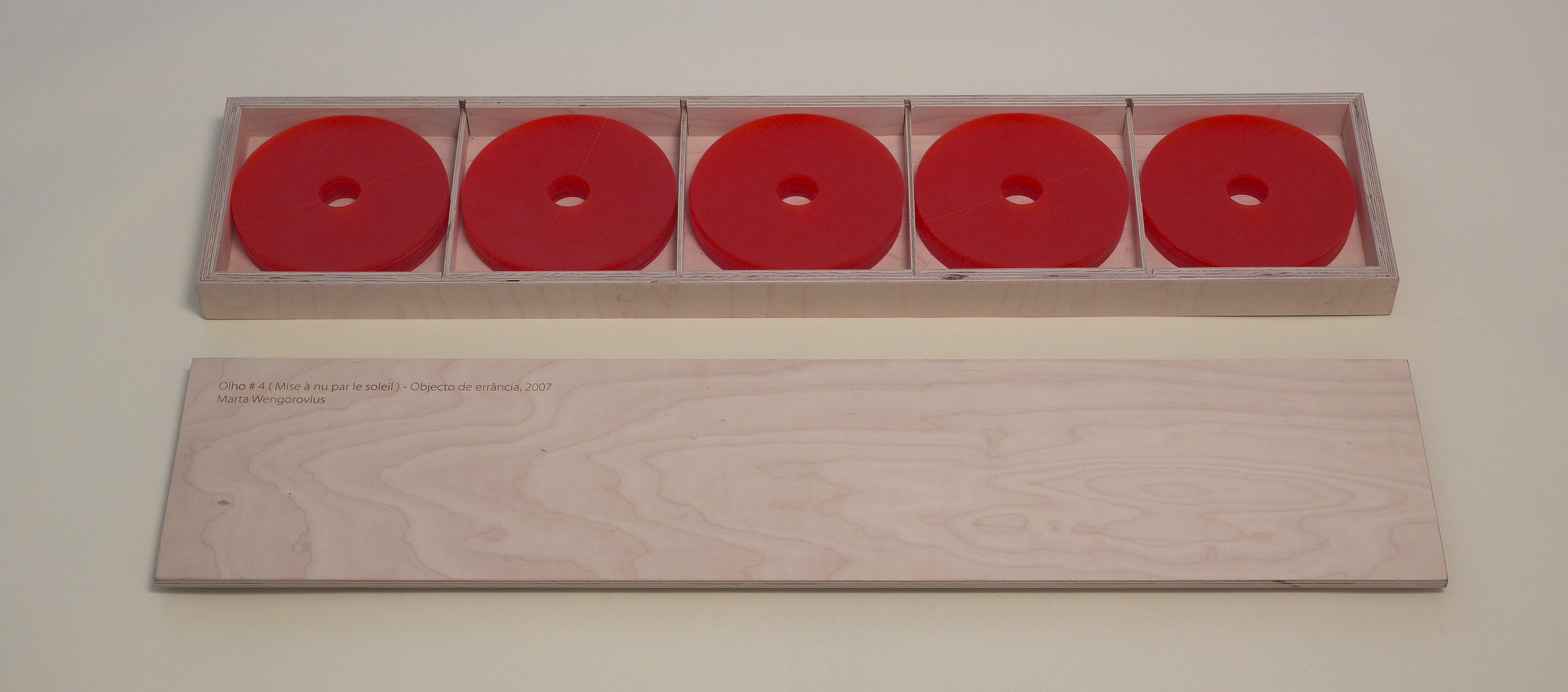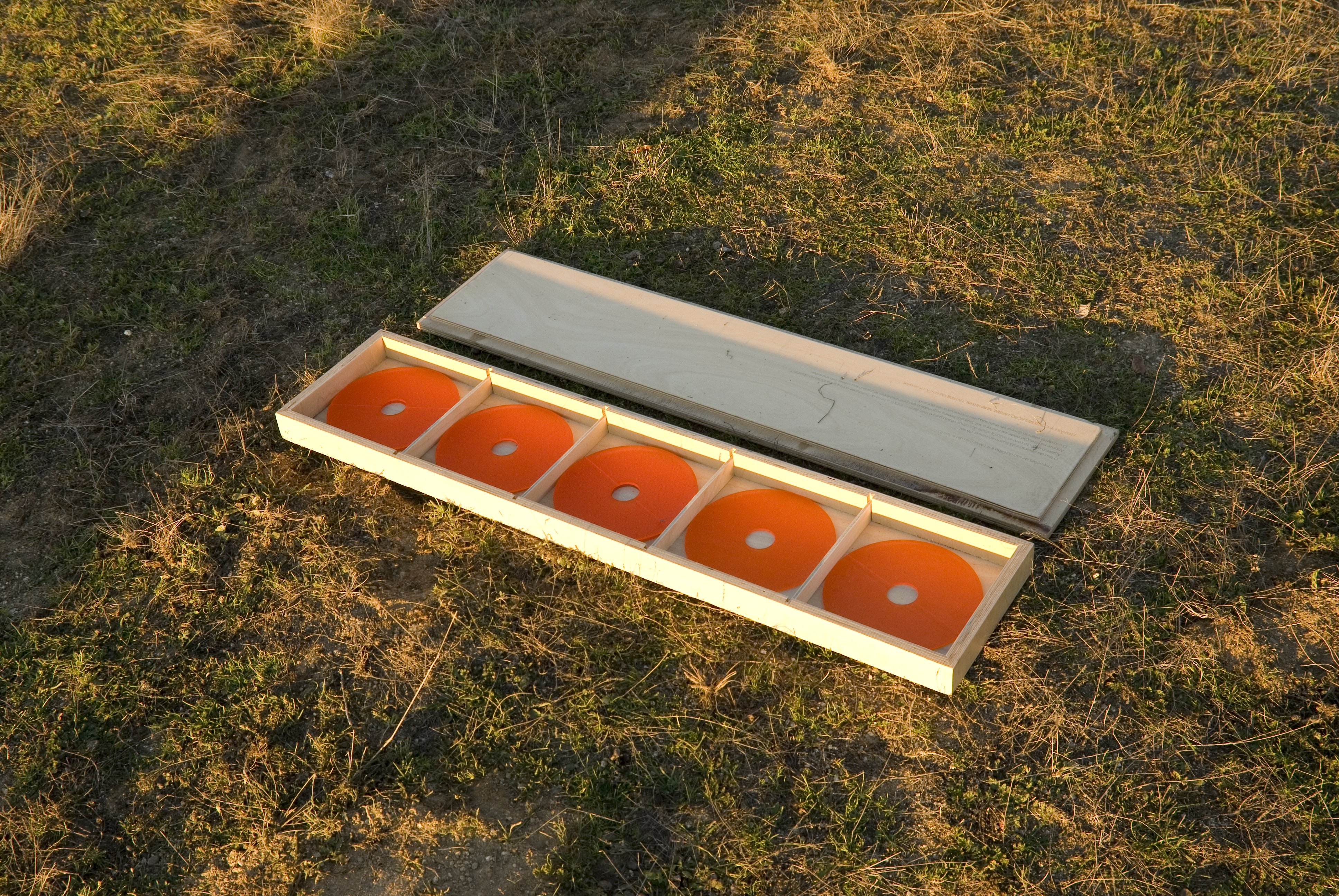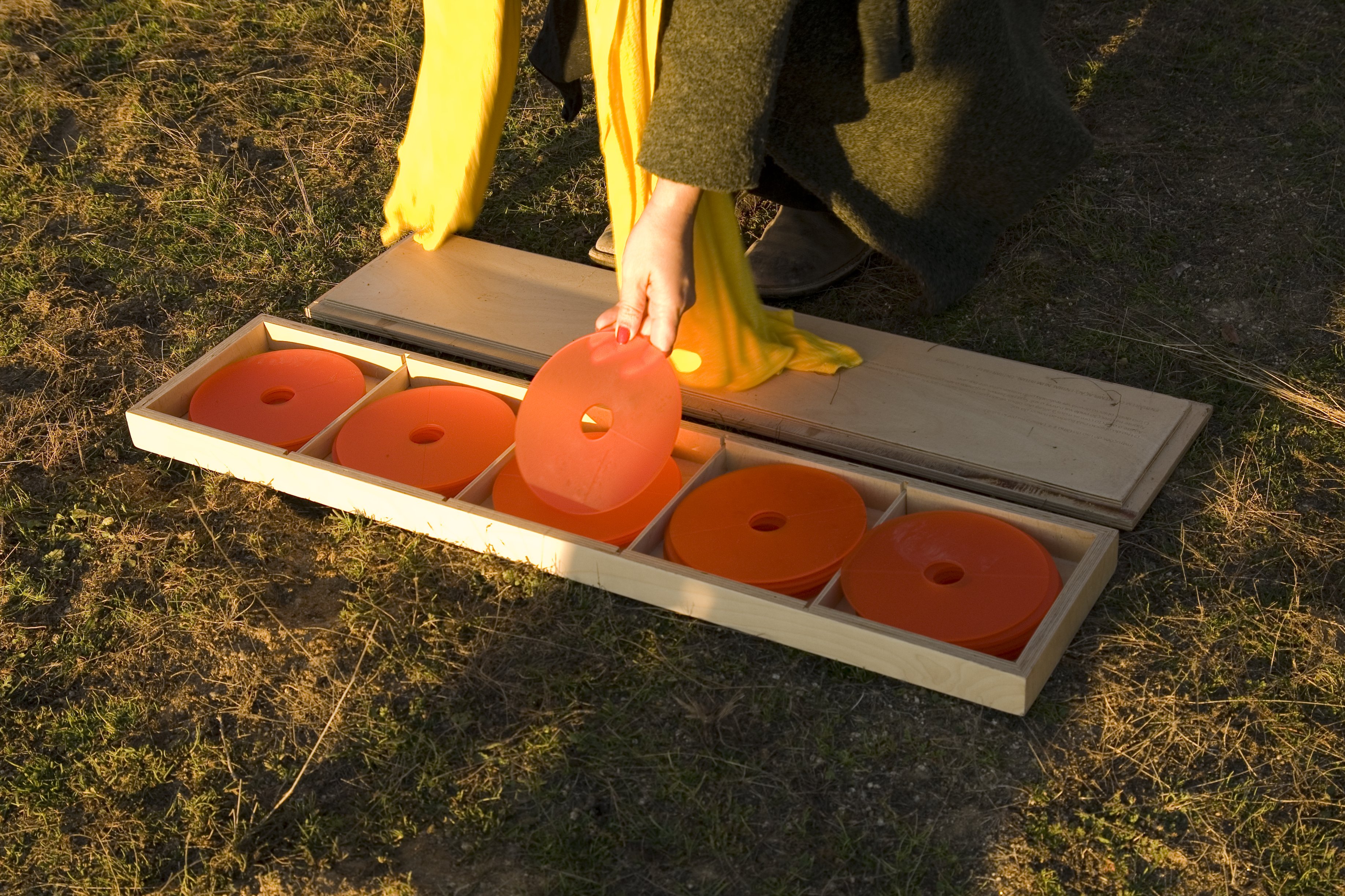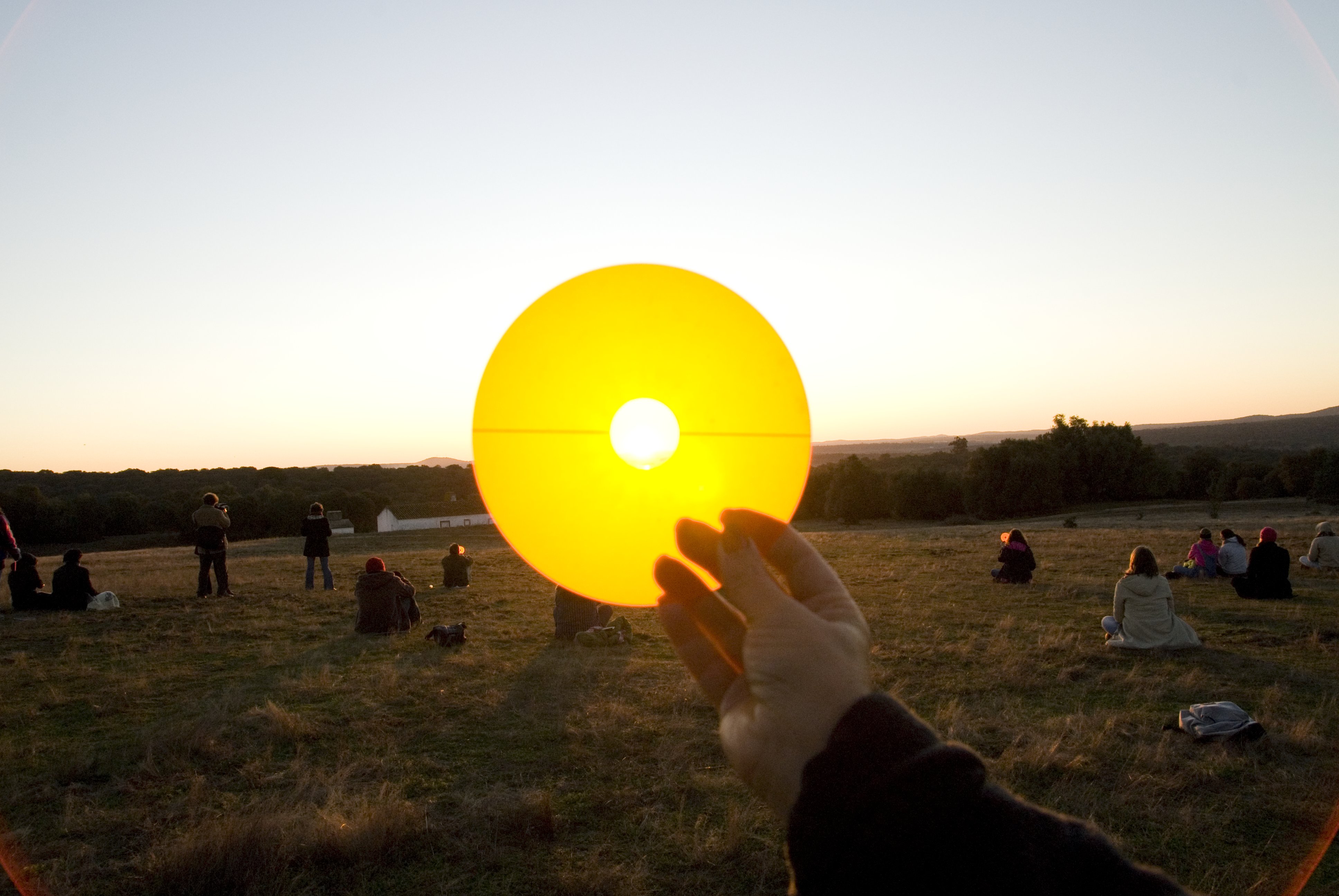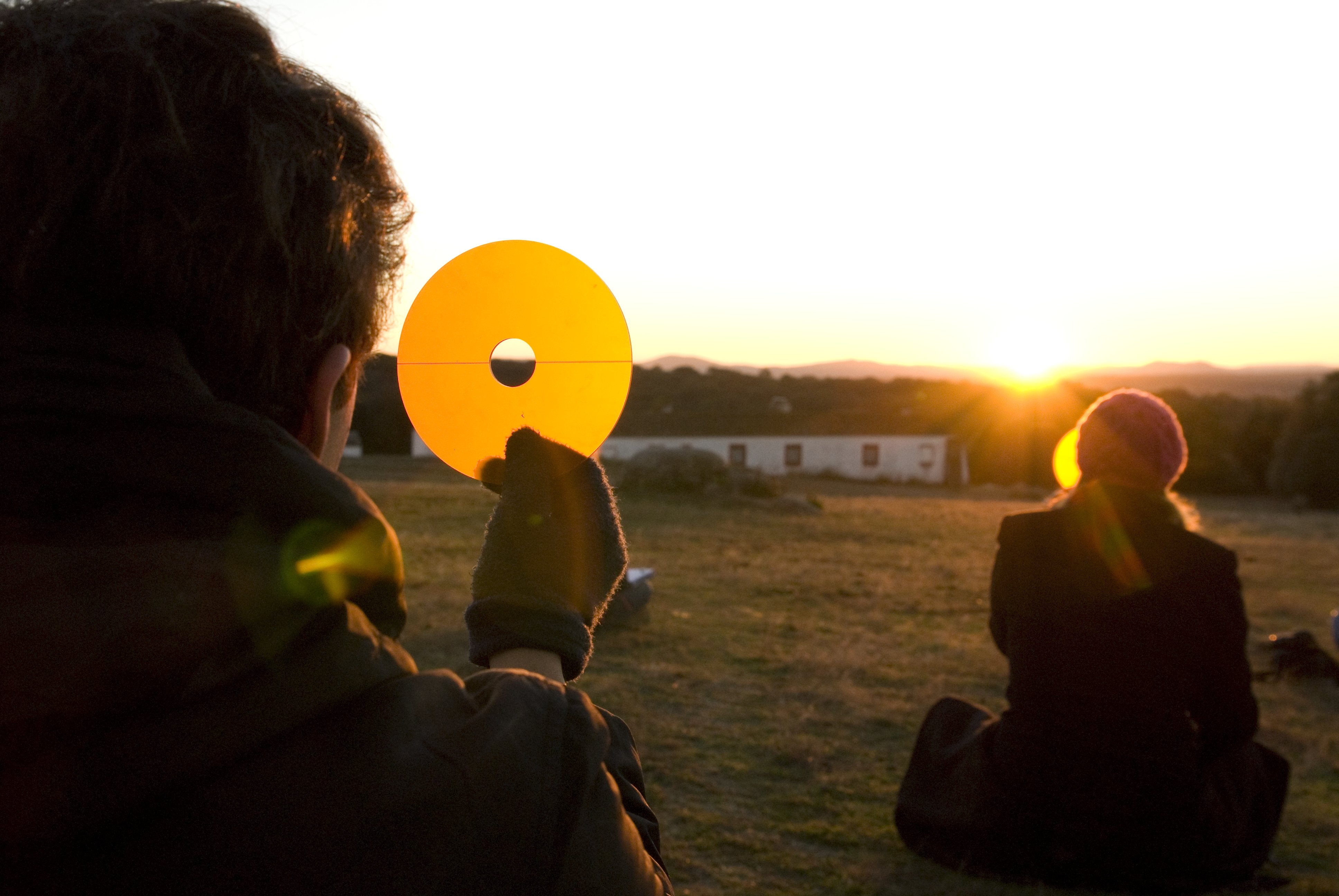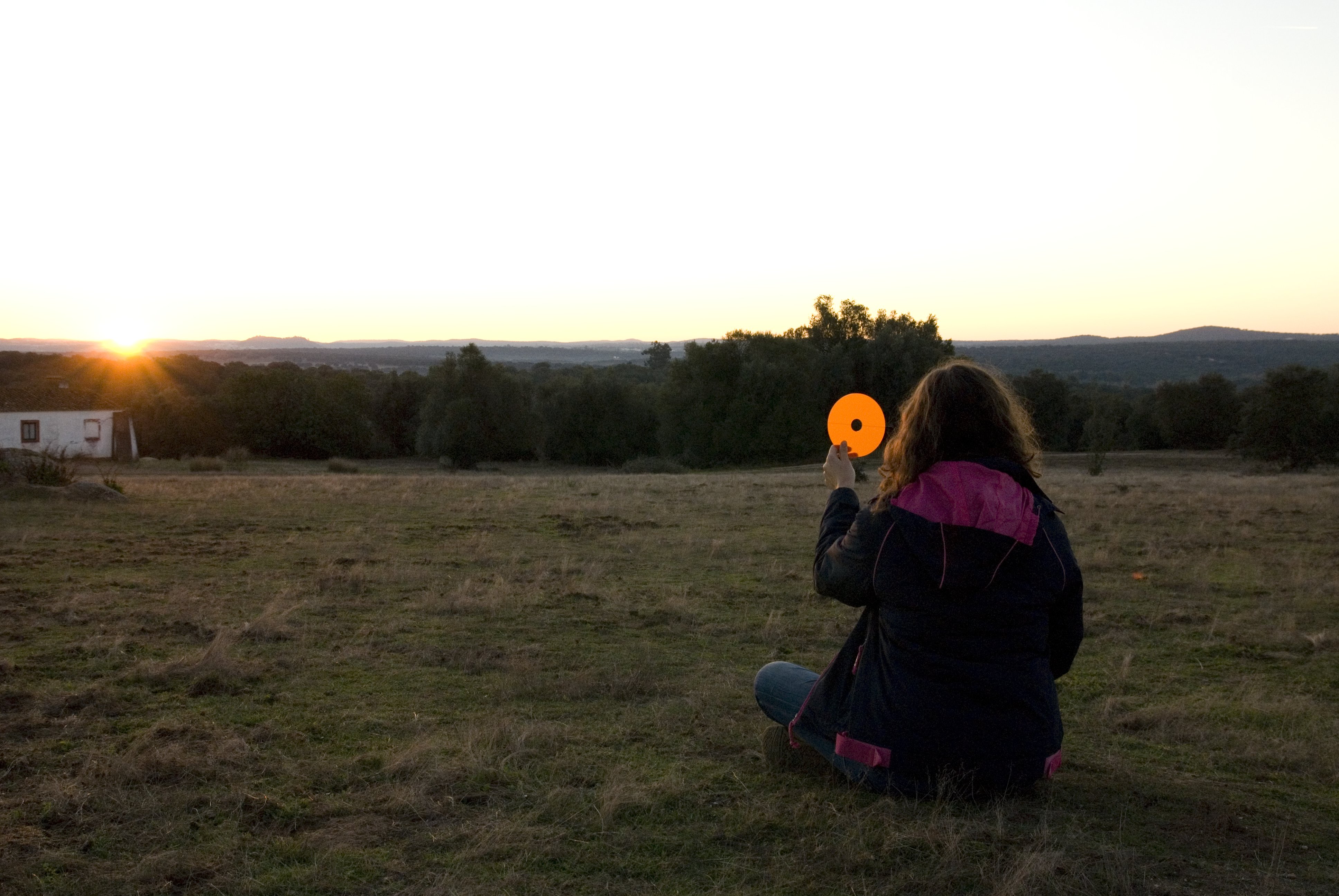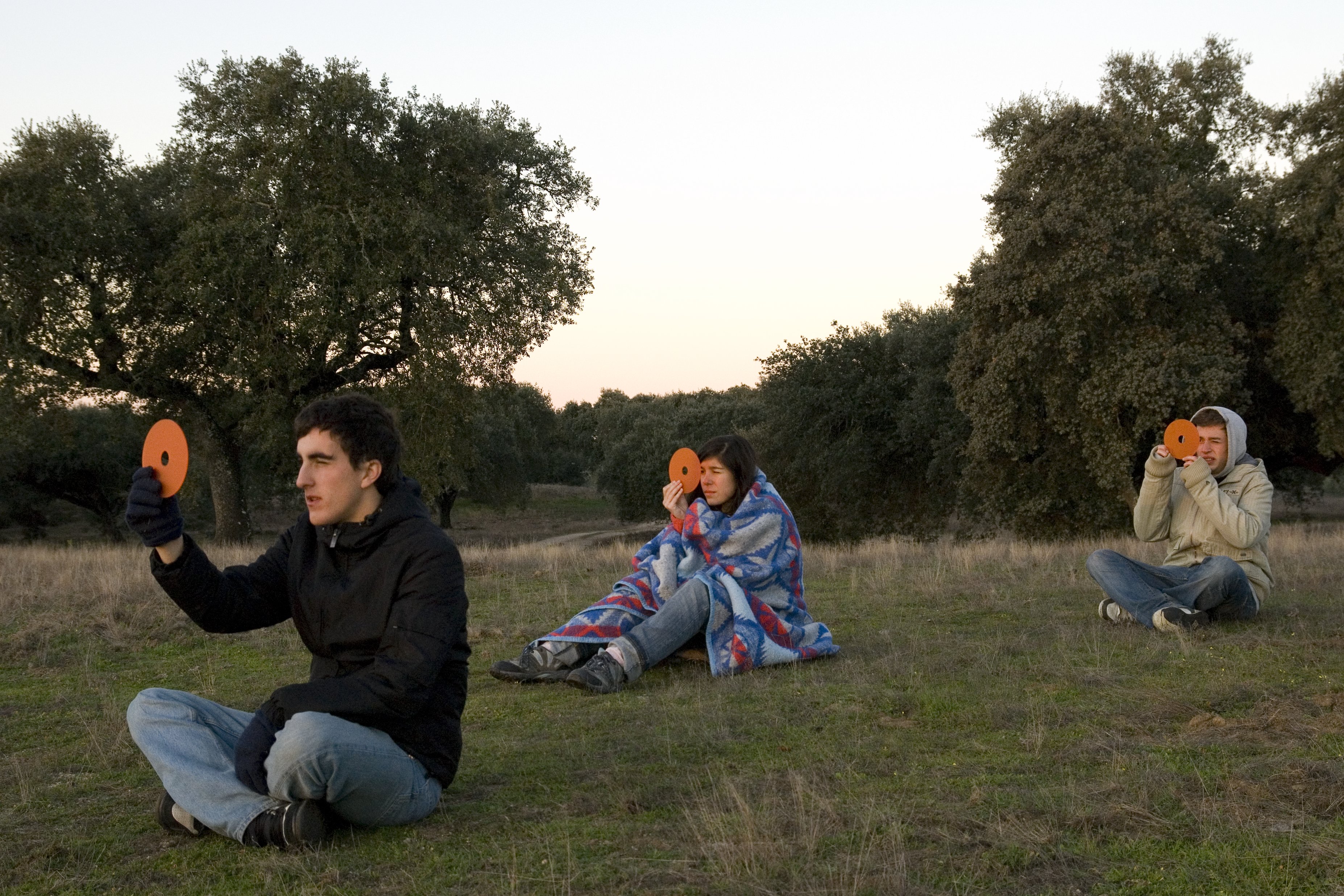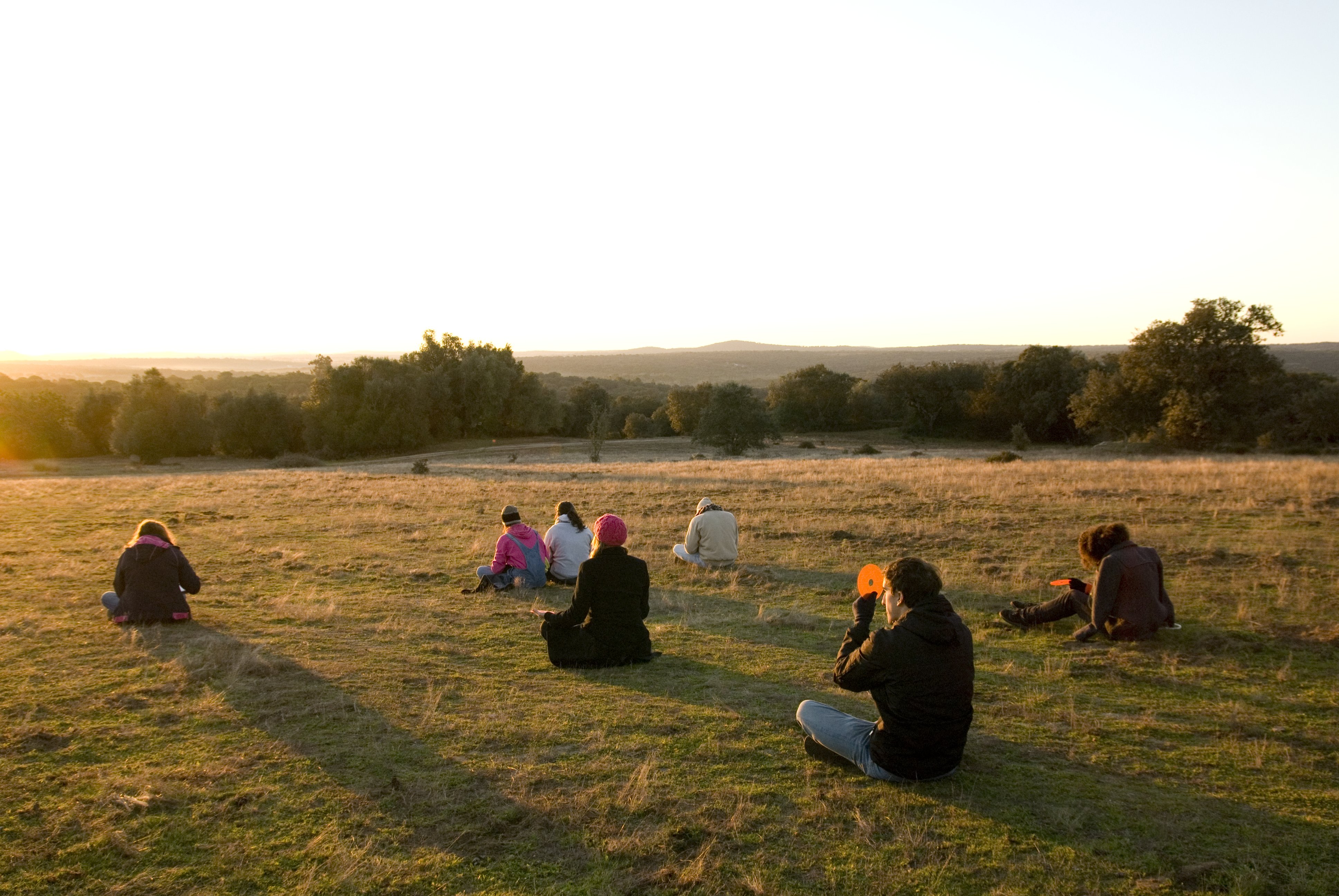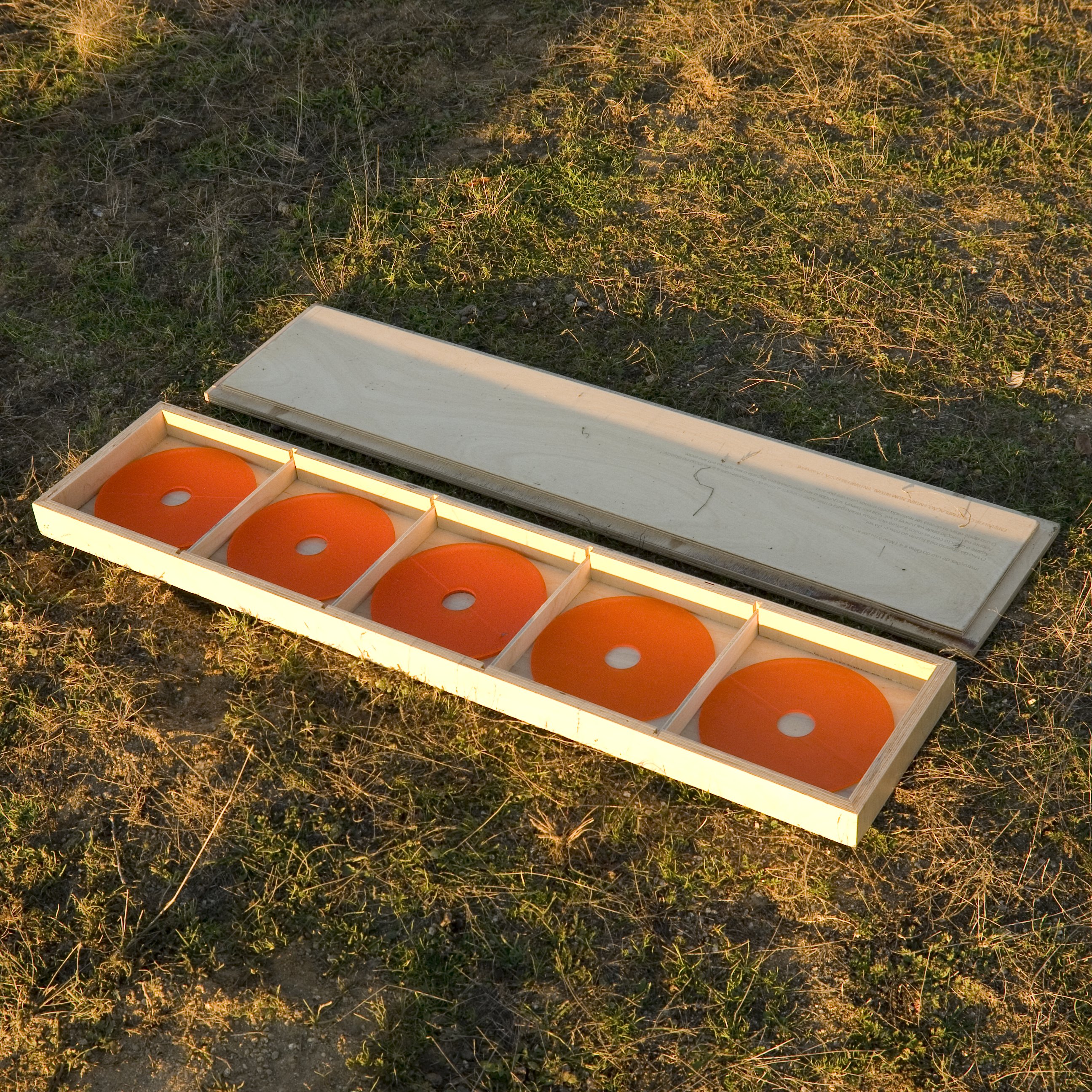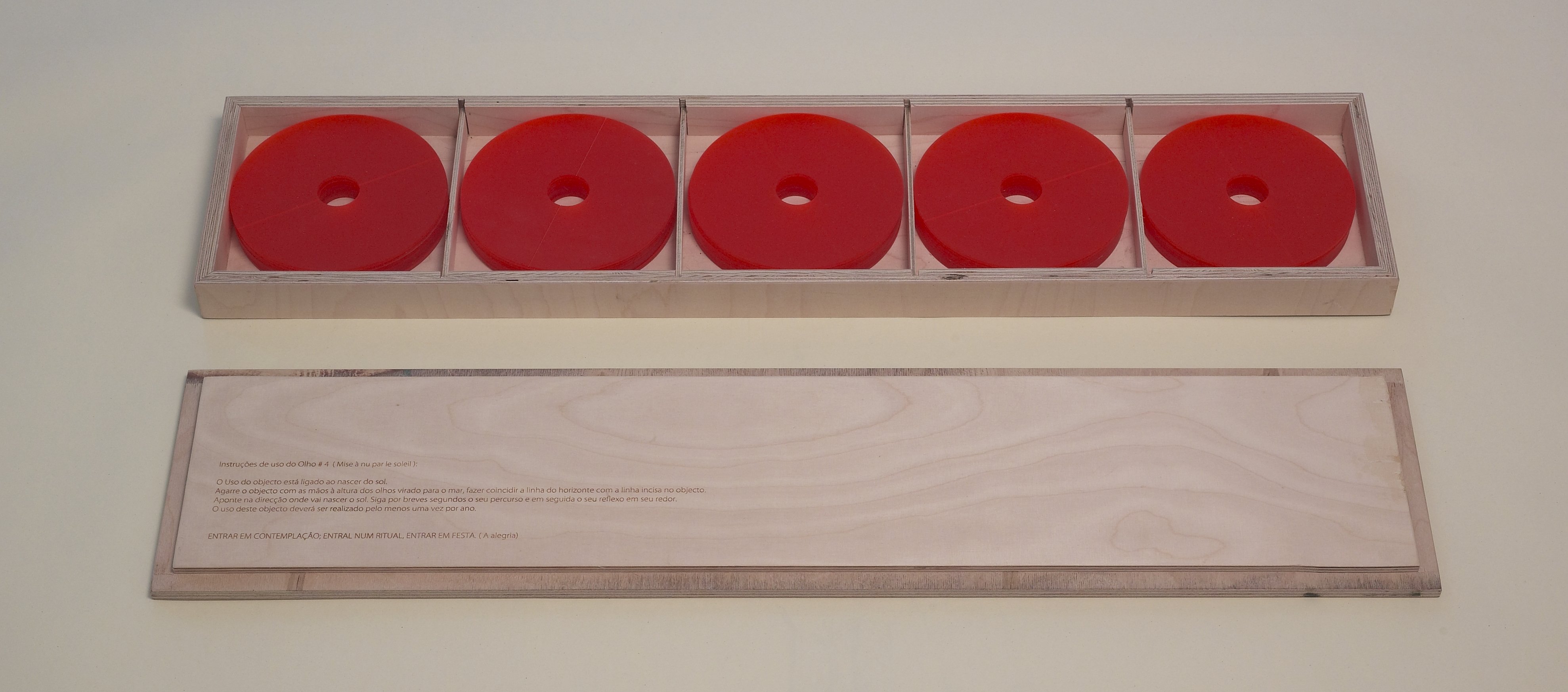Acrílico frosta laranja
Ø 15 cm e 3,5 cm, espessura 0,5cm
Instruções de uso Olho #4 (mise a nu par le soleil):
O uso do objecto está ligado ao nascer do Sol.
Agarre o objecto com as mãos à altura dos olhos, virado para o mar, fazer coincidir a linha do horizonte com a linha
incisa no objecto.
Aponte na direcção onde vai nascer o sol. Siga por breves segundos o seu percurso e em seguida o seu reflexo em
seu redor.
O uso deste objecto deverá ser realizado pelo menos uma vez por ano.
O Olho #4 é um objecto para ver o nascer do sol. É um objecto para ser agarrado pelas duas mãos e ser colocado à altura dos olhos de quem o transporta É para ser usado, dentro de uma embarcação, no mar. Usufrutuário deve virar-se para o lugar do nascer do sol; e posteriormente deve procurar o reflexo desse fenómeno ao seu redor. O conceito subjacente ao aparecimento deste Olho está estritamente ligado à observação do nascer do dia, e mais precisamente do aparecimento do Sol. Este é também o critério que está a ser usado para a escolha do local que, como disse já nesta dissertação, faz parte da obra. Assim a pesquisa do local de uso do Olho #4 tem-se baseado na escolha de um lugar onde seja possível o visionamento do sol quando este surge.
Depois de alguma pesquisa sobre o lugar ideal para ver este nascer do Sol, iniciou-se uma fase de inquirição. Perguntei a um conjunto indiferenciado de pessoas se já tinham visto o sol nascer e onde. As respostas eram evasivas. As que haviam visto não recordavam o local nem se teriam de facto visto o aparecimento do disco solar. Recordavam a experiência da luz da madrugada. A maioria dos inquiridos, sobretudo em Lisboa, tinha mesmo dúvidas sobre onde nascia o sol. Incluía-me neste grupo. Alguns recordavam o aparecimento do disco solar, e o fenómeno estava geralmente ligado a viagens, a outros lugares que não o que habitavam regularmente. A pesquisa sobre o lugar dá origem a duas grandes opções: em terra e no mar. Em terra o ponto de observação é fixo e no mar vai incluir, ainda que com a embarcação parada, a ondulação das águas. Em ambos, o que me interessa é a planura, a condição de visão sem obstáculo, o que nos dá uma ligação directa ao fenómeno.
Birch box with 50 pieces of acrylic frost orange
Ø 15 cm e 3,5 cm, thick 0,5cm
Instructions of use:
The use of the object is connected with dawn.
Hold the object with your hands at eye level facing the sea; align the line of the horizon with the line carved in the object. Point it in the direction of the place where the sun is going to emerge. Follow its trajectory for a few seconds, and then its reflection around it. This object should be used in this way at least once a year.
Olho #4 (Eye #4) is an acrylic object with a diameter of 15 cm and 5 mm thick, containing an empty centre with 3.5 cm of diameter. It is crossed by an incisive line 0.5 cm deep x 0.5 cm wide. This monochromatic circle and translucid material does not allow transparency; one can only see an object immediately close to the plan. It is also reception of light signals, forms in light dark or luminous movements.
This Eye is still in a pre-production phase (awaiting funding). The Olho #4 (Eye #4) is an object to see the sunrise. It is an object to be grabbed by the two hands and put at the carrier’s eye level. It is to be used inside a boat, in the sea. The user should turn to where the sun rises; and subsequently look for the reflection of this phenomenon on its surroundings. Description of the Project for Uso do Olho #4 (the use of Eye #4): The underlying concept for the constitution of this object is strictly connected to the observation of the beginning of the day, and more precisely to the observation of the appearance of the sun. This is also the criterion that is being used for the choice of the site, which, as already has been said in this dissertation, is part of the work. Therefore, the investigation of the place for the use of Olho #4 (Eye #4) has been based on the choice of a place on which the viewing of the sun rising can take place.
After some research about the ideal place to watch the sun rising, took place an inquisition stage. I have asked to an undifferentiated number of individuals if they had already seen the sun rising and where.
The answers were evasive. Those who had seen it could not recall neither the place nor if the appearance of the solar disk had actually been seen. They remembered the experience of the morning light. Most of the interviewed, principally those from Lisbon, had indeed doubts about where the sun rose. I was included in this group. Some recalled the appearance of the solar disk, and the phenomenon was usually linked to journeys, to other places besides the one they normally lived in.
The research about the site originates two big options: land or sea. On land the observation point is fixed and in the sea it will include, even if the boat is still, the waving of the waters. In both, what I’m interested in is the plainness, the condition of an obstacle free vision, which gives us a direct bond to the phenomenon.
- + PT
-
Acrílico frosta laranja
Ø 15 cm e 3,5 cm, espessura 0,5cmInstruções de uso Olho #4 (mise a nu par le soleil):
O uso do objecto está ligado ao nascer do Sol.
Agarre o objecto com as mãos à altura dos olhos, virado para o mar, fazer coincidir a linha do horizonte com a linha
incisa no objecto.
Aponte na direcção onde vai nascer o sol. Siga por breves segundos o seu percurso e em seguida o seu reflexo em
seu redor.
O uso deste objecto deverá ser realizado pelo menos uma vez por ano.
O Olho #4 é um objecto para ver o nascer do sol. É um objecto para ser agarrado pelas duas mãos e ser colocado à altura dos olhos de quem o transporta É para ser usado, dentro de uma embarcação, no mar. Usufrutuário deve virar-se para o lugar do nascer do sol; e posteriormente deve procurar o reflexo desse fenómeno ao seu redor. O conceito subjacente ao aparecimento deste Olho está estritamente ligado à observação do nascer do dia, e mais precisamente do aparecimento do Sol. Este é também o critério que está a ser usado para a escolha do local que, como disse já nesta dissertação, faz parte da obra. Assim a pesquisa do local de uso do Olho #4 tem-se baseado na escolha de um lugar onde seja possível o visionamento do sol quando este surge.
Depois de alguma pesquisa sobre o lugar ideal para ver este nascer do Sol, iniciou-se uma fase de inquirição. Perguntei a um conjunto indiferenciado de pessoas se já tinham visto o sol nascer e onde. As respostas eram evasivas. As que haviam visto não recordavam o local nem se teriam de facto visto o aparecimento do disco solar. Recordavam a experiência da luz da madrugada. A maioria dos inquiridos, sobretudo em Lisboa, tinha mesmo dúvidas sobre onde nascia o sol. Incluía-me neste grupo. Alguns recordavam o aparecimento do disco solar, e o fenómeno estava geralmente ligado a viagens, a outros lugares que não o que habitavam regularmente. A pesquisa sobre o lugar dá origem a duas grandes opções: em terra e no mar. Em terra o ponto de observação é fixo e no mar vai incluir, ainda que com a embarcação parada, a ondulação das águas. Em ambos, o que me interessa é a planura, a condição de visão sem obstáculo, o que nos dá uma ligação directa ao fenómeno.
- + EN
-
Birch box with 50 pieces of acrylic frost orange
Ø 15 cm e 3,5 cm, thick 0,5cmInstructions of use:
The use of the object is connected with dawn.
Hold the object with your hands at eye level facing the sea; align the line of the horizon with the line carved in the object. Point it in the direction of the place where the sun is going to emerge. Follow its trajectory for a few seconds, and then its reflection around it. This object should be used in this way at least once a year.
Olho #4 (Eye #4) is an acrylic object with a diameter of 15 cm and 5 mm thick, containing an empty centre with 3.5 cm of diameter. It is crossed by an incisive line 0.5 cm deep x 0.5 cm wide. This monochromatic circle and translucid material does not allow transparency; one can only see an object immediately close to the plan. It is also reception of light signals, forms in light dark or luminous movements.
This Eye is still in a pre-production phase (awaiting funding). The Olho #4 (Eye #4) is an object to see the sunrise. It is an object to be grabbed by the two hands and put at the carrier’s eye level. It is to be used inside a boat, in the sea. The user should turn to where the sun rises; and subsequently look for the reflection of this phenomenon on its surroundings. Description of the Project for Uso do Olho #4 (the use of Eye #4): The underlying concept for the constitution of this object is strictly connected to the observation of the beginning of the day, and more precisely to the observation of the appearance of the sun. This is also the criterion that is being used for the choice of the site, which, as already has been said in this dissertation, is part of the work. Therefore, the investigation of the place for the use of Olho #4 (Eye #4) has been based on the choice of a place on which the viewing of the sun rising can take place.
After some research about the ideal place to watch the sun rising, took place an inquisition stage. I have asked to an undifferentiated number of individuals if they had already seen the sun rising and where.
The answers were evasive. Those who had seen it could not recall neither the place nor if the appearance of the solar disk had actually been seen. They remembered the experience of the morning light. Most of the interviewed, principally those from Lisbon, had indeed doubts about where the sun rose. I was included in this group. Some recalled the appearance of the solar disk, and the phenomenon was usually linked to journeys, to other places besides the one they normally lived in.The research about the site originates two big options: land or sea. On land the observation point is fixed and in the sea it will include, even if the boat is still, the waving of the waters. In both, what I’m interested in is the plainness, the condition of an obstacle free vision, which gives us a direct bond to the phenomenon.


